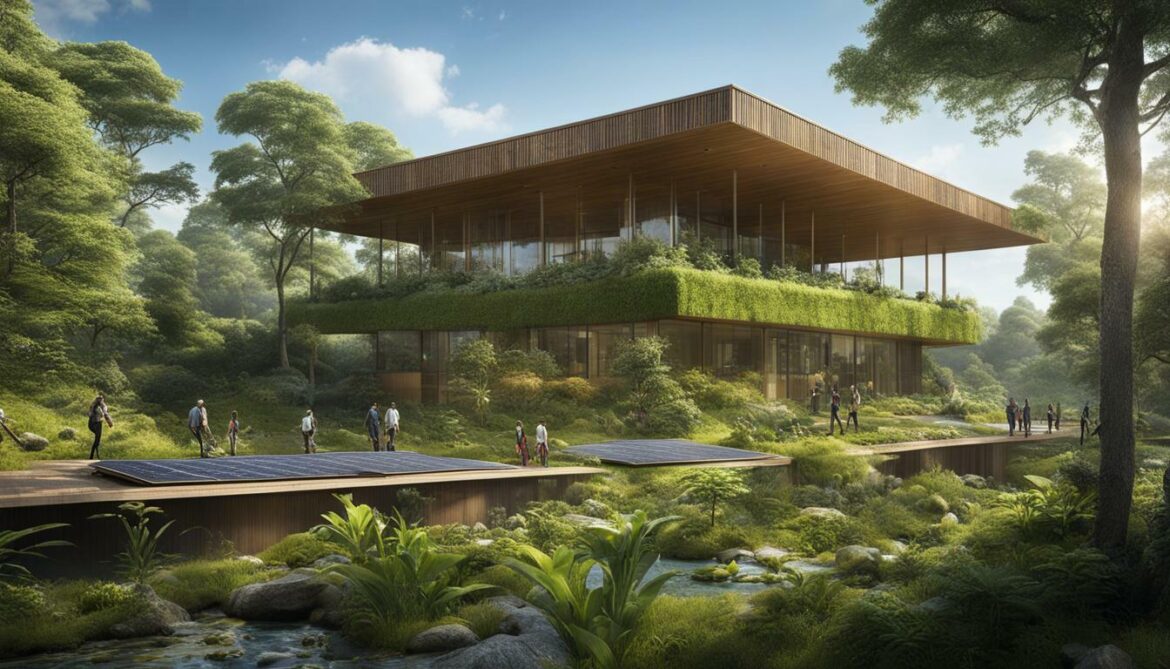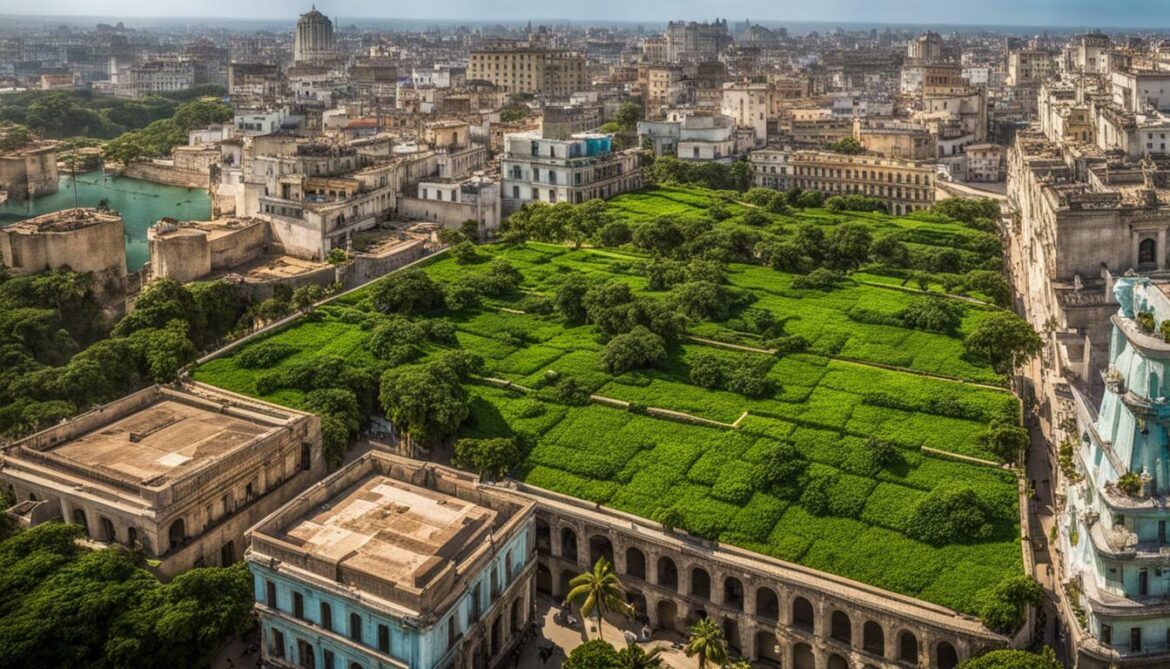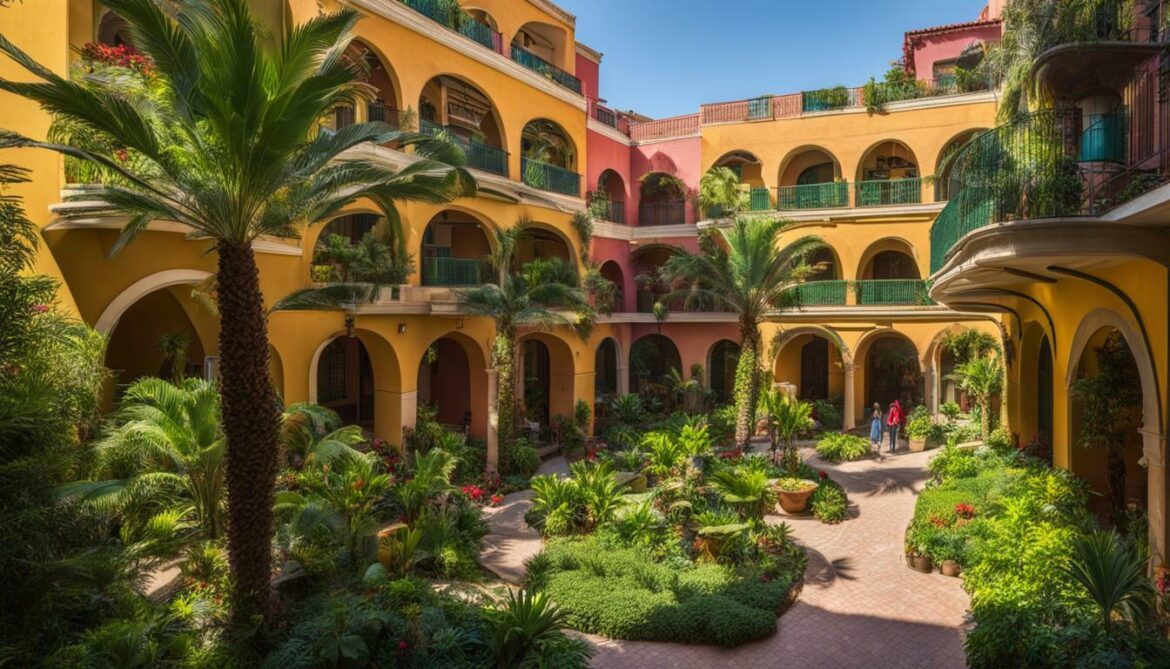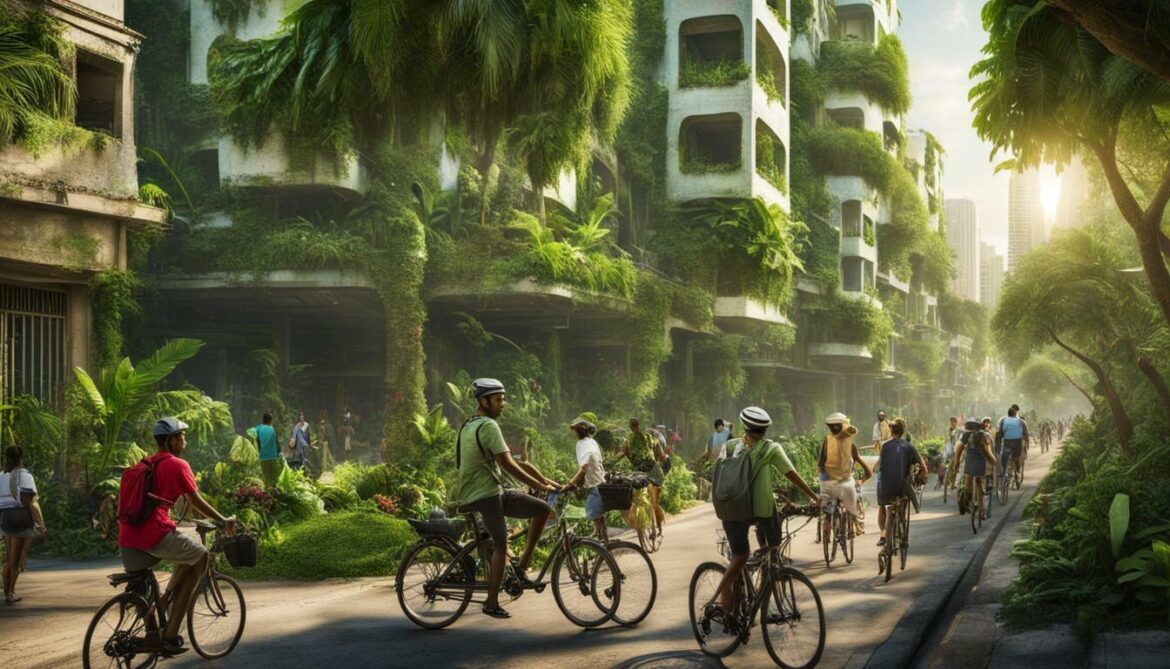When it comes to sustainable architecture, Cuba has a rich history of eco-friendly construction practices. From the early green building initiatives to the rise of energy-efficient buildings, Cuba has been at the forefront of sustainable development in architecture.
Over the years, Cuban architects have embraced innovative approaches to reduce the environmental impact of buildings, using sustainable building materials and integrating renewable energy sources. The intersection of sustainable architecture and Cuban culture has resulted in the preservation of cultural heritage and enhanced quality of life for residents.
In this article, we will delve into the fascinating history of green building in Cuba, exploring the evolution of sustainable architecture and eco-friendly construction practices that have been embraced throughout the years.
- Cuba has a rich history of eco-friendly construction practices and sustainable architecture.
- The early green building initiatives in Cuba led to the emergence of sustainable design principles.
- Cuban architects have embraced innovative approaches such as the use of sustainable materials and energy-saving technologies.
- The intersection of sustainable architecture and Cuban culture has resulted in the preservation of cultural heritage and enhanced quality of life for residents.
- Green building initiatives in Cuba continue to progress towards a more sustainable future for the country’s architecture.
The Beginnings of Sustainable Architecture in Cuba
Green building initiatives in Cuba began to gain traction in the early 1990s when the country faced an economic crisis and a shortage of resources. The pressing need to conserve energy and reduce carbon emissions led to a renewed focus on sustainable development in Cuban architecture.
During this period, Cuban architects started to embrace sustainable design principles, taking inspiration from traditional Cuban building techniques that prioritize natural ventilation, shading, and rainwater collection. By adopting these practices, architects were able to reduce the environmental impact of buildings while also keeping them cool and comfortable in Cuba’s warm climate.
The Emergence of Sustainable Design Principles
Sustainable development in Cuban architecture gained momentum during the 2000s when the Cuban government launched a series of green building initiatives. These initiatives aimed to promote the use of renewable energy sources, reduce energy consumption, and encourage eco-friendly construction practices.
Architects started to experiment with sustainable building materials such as bamboo, recycled steel, and compressed earth blocks, which were readily available in Cuba. They also began to incorporate energy-saving technologies such as solar water heaters and photovoltaic panels into their designs.
As a result of these efforts, Cuba has become a leader in sustainable architecture in the Caribbean region, with many award-winning green buildings that showcase innovative design solutions to environmental challenges.

Before sustainable development took center stage, Cuban buildings had a significant environmental impact. Many buildings were constructed without proper insulation, which led to high energy consumption for heating and cooling. In addition, the use of non-renewable resources like concrete and steel contributed to carbon emissions and environmental degradation.
However, with the adoption of sustainable design principles, Cuban buildings have become more energy-efficient and eco-friendly. Architects have incorporated passive design strategies such as natural ventilation, passive cooling and solar shading, and water conservation measures into their projects. They have also utilized locally-available building materials and reduced the use of non-renewable resources, making Cuban buildings more sustainable and less harmful to the environment.
The Future of Sustainable Development in Cuban Architecture
Cuba’s commitment to sustainable development in architecture is ongoing, and the country continues to implement innovative green building initiatives. In recent years, the government has invested heavily in renewable energy sources, with plans to increase the use of solar, wind, and hydroelectric power.
Architects in Cuba are also exploring new technologies and materials to improve the sustainability of buildings. They are working with innovative building systems like modular construction, which minimizes waste and reduces the carbon footprint of buildings. They are also experimenting with new materials such as hempcrete, a type of concrete made with hemp and lime, which is both sustainable and affordable.
In conclusion, the beginnings of sustainable architecture in Cuba have paved the way for a greener future. The country’s green building initiatives, sustainable design principles, and innovative solutions have made Cuban architecture a shining example of sustainable development in the Caribbean region.
Green Design in Cuban Construction
Green design principles have been embraced in Cuban construction, with a focus on sustainable building materials and innovative approaches to reducing environmental impact. Cuba has a rich history of sustainable architecture, and this has been reflected in the adoption of eco-friendly construction practices.
One of the key sustainable building materials used in Cuban construction is bamboo. This durable, rapidly renewable material is used in a variety of ways, from flooring and wall coverings to structural elements and furniture. Bamboo is known for its strength and versatility, as well as its environmentally friendly properties.
Another popular sustainable building material used in Cuba is adobe. Made from locally sourced, natural materials, adobe is an excellent insulator and has a low carbon footprint. It is also a cost-effective option, as it can be easily produced using local resources.
Cuban architects have also been innovative in their use of recycled materials. For example, shipping containers have been repurposed as housing units, demonstrating an inventive approach to sustainable design.

Overall, the use of sustainable building materials and green design principles in Cuban construction reflects a commitment to preserving the environment for future generations. By embracing eco-friendly construction practices, Cuba has demonstrated its leadership in sustainable development and provides a valuable example for other countries to follow.
The Rise of Energy-Efficient Buildings in Cuba
As Cuba continues to prioritize sustainable development in Cuban architecture, the adoption of energy-efficient buildings has been a significant achievement. With a focus on reducing energy consumption and promoting renewable energy sources, Cuba’s green building initiatives have set an impressive example for other countries to follow.
One of the ways in which Cuba has achieved energy efficiency in buildings is through the integration of renewable energy sources such as solar power. The use of solar panels in buildings has grown significantly over the years, providing a reliable and sustainable source of energy. This integration not only helps to reduce the energy consumption of buildings but also contributes to the overall reduction of greenhouse gas emissions.
In addition, the adoption of energy-saving technologies in Cuban construction has also contributed to the rise of energy-efficient buildings. For instance, the use of LED lighting, which consumes less energy than traditional lighting, has become a popular choice in many Cuban buildings. The installation of intelligent building systems that can control lighting and HVAC systems has also helped to reduce energy usage significantly.
Furthermore, the use of sustainable building materials such as insulation made from recycled materials has also contributed to the energy efficiency of buildings in Cuba. These materials provide better insulation, reducing the energy required for heating and cooling, which in turn lowers the overall energy consumption of buildings.

The implementation of these eco-friendly practices has not only contributed to a greener environment but has also provided significant economic benefits. Energy-efficient buildings have lower operating costs, reducing the financial burden on building owners and tenants. Furthermore, the use of sustainable practices has created new green jobs, promoting a sustainable economy and enhancing the quality of life for Cubans.
The rise of energy-efficient buildings in Cuba is a significant achievement in the country’s efforts towards sustainable development in Cuban architecture. As Cuba continues to prioritize green building initiatives, the integration of renewable energy sources and energy-efficient technologies will undoubtedly play an essential role in the future of Cuban construction.
The Historical Context of Green Building in Cuba
Understanding the historical context of green building in Cuba provides insight into the evolution of sustainable architecture in the country. Cuba has a long history of facing environmental challenges, from deforestation to soil erosion, which have influenced the development of sustainable building practices.
In the early 20th century, Cuba experienced significant economic growth, which led to a construction boom. However, these buildings were often constructed with little regard for environmental impact, resulting in increased pollution and resource depletion.
Following the Cuban Revolution in 1959, the government prioritised environmental conservation and sustainable development. This shift in focus led to a renewed interest in green building practices, with an emphasis on using locally-sourced, eco-friendly materials.
The concept of sustainable architecture was further developed in the 1990s, following the collapse of the Soviet Union and the resulting economic crisis in Cuba. The lack of resources and availability of building materials forced architects and builders to adopt innovative approaches to green design, such as using recycled materials and incorporating passive solar design principles.
The historical context of green building in Cuba continues to shape sustainable development in the country today, with architects and builders embracing innovative solutions to reduce environmental impact and preserve natural resources.

Cuba’s rich history of facing environmental challenges has influenced the development of sustainable building practices.
Sustainable Architecture and Cuban Culture
The intersection of sustainable architecture and Cuban culture is a fascinating topic. Eco-friendly construction practices have been embraced as a way to preserve cultural heritage and enhance the quality of life for residents.
Cuba’s unique cultural identity is reflected in its architecture, which is a hybrid of various styles. The country’s colonial past, combined with the influence of African and indigenous cultures, has resulted in a rich architectural heritage.
Over the years, sustainable architecture has become an integral part of Cuban culture. The use of natural materials such as wood, bamboo and adobe, has been a key feature of eco-friendly construction practices. These materials not only reduce the environmental impact of buildings but also provide a link to Cuba’s cultural heritage.
Another aspect of sustainable architecture that is deeply rooted in Cuban culture is the importance placed on community and social well-being. The design of buildings takes into consideration the needs of the community and aims to enhance the quality of life for residents.
One example of sustainable design in Cuban architecture is the concept of “porches”. These covered outdoor spaces provide shade and allow for natural ventilation, reducing the need for artificial cooling. They also serve as a communal space where residents can gather and socialize.
The integration of sustainable design principles into Cuban architecture is a testament to the country’s commitment to preserving its cultural heritage while embracing a greener future.

“The use of natural materials and the design of buildings that take into consideration the needs of the community are just some of the ways in which sustainable architecture is deeply rooted in Cuban culture.”
Innovative Solutions and Future Prospects
Today, green building initiatives in Cuba continue to gain momentum, with sustainability being a key driver of development in Cuban architecture. One major trend is the development of eco-friendly neighbourhoods, which incorporate green spaces, bike paths, and other sustainable features. The use of locally sourced, renewable materials for buildings is also on the rise.
A significant development in recent years has been the adoption of energy-efficient technologies, such as solar panels, to reduce energy consumption and costs in buildings. The integration of these technologies has been supported by governmental policies, such as the reduction of import taxes for renewable energy equipment.
Another area of focus is the preservation of historic buildings through sustainable restoration practices. These efforts help to maintain the cultural heritage of Cuba while reducing the environmental impact of restoration projects.
Looking forward, there are many promising prospects for sustainable development in Cuban architecture. One exciting initiative is the creation of green building rating systems, which will help to standardize sustainable practices in construction and encourage more widespread adoption of eco-friendly design principles.
Cuba’s commitment to sustainable development in its architecture is a positive sign for the future of the country and the planet as a whole. By continuing to embrace innovative solutions and integrate sustainable practices into its building industry, Cuba can lead the way towards a greener tomorrow.

“Sustainable development is the pathway to the future we want for all. It offers a framework to generate economic growth, achieve social justice, exercise environmental stewardship, and strengthen governance.” – Ban Ki-moon
The Conclusion: Embracing Sustainable Practices for a Greener Tomorrow
Throughout this article, we have explored the fascinating history of green building in Cuba, from the beginnings of sustainable architecture to the rise of energy-efficient buildings. We have highlighted the innovative solutions that have been implemented to reduce the ecological footprint of buildings in Cuba, and the ongoing green building initiatives that offer great prospects for sustainable development.
The historical context of green building in Cuba has been significant, with societal and environmental needs driving the evolution of sustainable architecture. The integration of eco-friendly construction practices has been embraced as a way to preserve cultural heritage and enhance the quality of life for residents.
As we look to the future, it is clear that the adoption of sustainable practices is imperative for creating a greener tomorrow. The potential impact of green building initiatives in Cuba cannot be overstated. By continuing to embrace sustainable development, Cuba has the potential to become a model for green building within the region.
Therefore, we invite readers to join us in embracing sustainable practices as we continue to shape the future of the built environment. By learning from Cuba’s rich history of green building, we can all work together to create a more sustainable and environmentally friendly future.
FAQ
What is the history of green building in Cuba?
The history of green building in Cuba is fascinating. It encompasses the evolution of sustainable architecture and the adoption of eco-friendly construction practices throughout the years.
When did sustainable architecture start in Cuba?
Sustainable architecture started to shape Cuban construction practices in the early years, with the emergence of green building initiatives and a focus on sustainable development.
How does green design play a role in Cuban construction?
Green design is a fundamental aspect of Cuban construction. It involves the use of sustainable building materials and innovative approaches to reduce the ecological impact of buildings.
What strides have been made in energy-efficient buildings in Cuba?
Cuba has made significant strides in energy-efficient buildings, integrating renewable energy sources and adopting energy-saving technologies to promote sustainability in construction.
What is the historical context of green building in Cuba?
The historical context of green building in Cuba is shaped by various factors that have influenced the development of sustainable architecture over time, considering societal and environmental needs.
How does sustainable architecture connect with Cuban culture?
Sustainable architecture in Cuba is deeply interconnected with Cuban culture, as eco-friendly construction practices are embraced to preserve cultural heritage and enhance the quality of life for residents.
What innovative solutions are being implemented in Cuban architecture?
Cuban architecture is embracing innovative solutions to promote sustainable development, with ongoing green building initiatives that have the potential to shape the future of construction in Cuba.
What is the importance of Cuba’s green building history?
Cuba’s green building history is of great significance in fostering a greener tomorrow. It highlights the importance of sustainable architecture in addressing environmental challenges and invites everyone to embrace sustainable practices.
























Post comments (0)